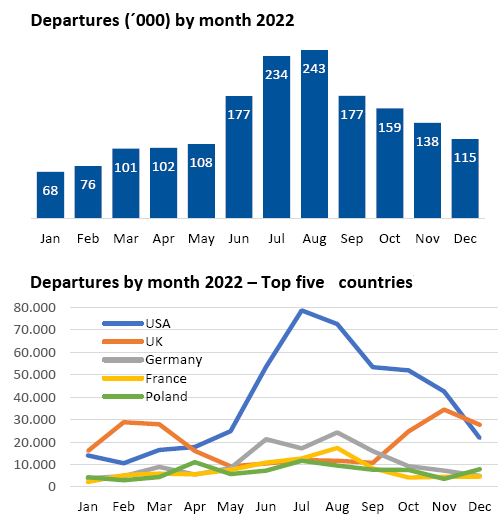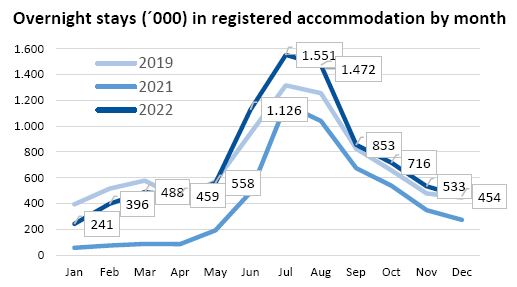Tourism in Iceland in Figures, January 2023: Summary for the year 2022
Tourism in Iceland in figures – January 2023 presents a summary of tourism statistics for the year 2022, including international visitor departures via Keflavík Airport, overnight stays in registered accommodation, hotel occupancy rates and information about visitors, e.g. the main purpose of their trips, length of stay and regions visited.
 Just under 1.7 million international visitors in 2022*
Just under 1.7 million international visitors in 2022*
Nearly 1.7 million international visitors came to Iceland in 2022, which was just over one million more than in 2021, 85% of the figure for 2019 and 73% of the record set in 2018.
By country, visitors from the USA were the largest group, accounting for more than a quarter (27%) of the total, at nearly 460,000 – more than twice as many as in 2021 and close to the figure for 2019. Visitors from the UK, at about 230,000, formed the second largest group, four times as many as in 2021 and 88% of their number for 2019. Germany was the country of provenance of the third-largest group, 132,000, which was more than twice the corresponding figure for 2021 and back to the level of 2019; France and Poland supplied the fourth- and fifth-largest numbers by country.
The vast majority of international visitors last year – about nine out of ten – were holidaymakers; 3.2% came to visit friends and family and 2.9% were on business trips. About 2.6% stated other reasons for their visits.
Average length of stay 7.4 nights**
On average, Iceland’s international visitors spent 7.4 nights in the country last year, slightly longer than in pre-Covid days (6.6 nights in 2019 and 6.3 in 2018). The increase was attributed to changes in travel patterns following the pandemic, and was observable long into 2022, with the longest stays in July (9.0 nights) and August (8.9) and the shortest in December (5.5), February (5.6) and November (5.7).
US visitors stayed in Iceland for an average of 6.6 nights in 2022, about one night longer than in 2019 and 2018; in view of their numbers, this change weighed heaviest in the overall figure. Of the ten largest groups by country of provenance, German and French tourists stayed longest in Iceland last year, averaging nearly 10 nights and just over nine, respectively.
More registered overnight stays than in 2019
Statistics Iceland recorded just under 9 million overnight stays in registered accommodation last year, which was nearly 4 million above the figure for 2021 (an increase of 77%) and 440,000 more than in 2019 (a 5.2% increase). A breakdown of the figures shows how occupancy by Icelanders during the Covid pandemic made up, to some extent, for the drop in international visitor numbers: domestic travellers accounted for 39% of overnight stays in 2019 and 45% in 2020. Icelandic holidaymakers accounted for about one fifth of the total in 2022, against 13% in 2018 and 2019, before the pandemic struck.
Just over half (53%) of overnight stays last year were in hotels, 14% in guesthouses and just under a third (32%) in other types of accommodation.
Nearly half of the stays (46%) took place during the three summer months.
US and Icelandic travellers nearly half of all overnight hotel guests
At 4.7 million, the number of overnight stays in hotels in 2022 was 91% above the 2021 figure, but 166,000 lower than that for 2019.
About a quarter of all overnight hotel guests last year (close to 1.2 million) were from the USA and about one fifth (934,000) were domestic travellers. Visitors from the UK, Germany and France formed the next three largest groups.
Hotel occupancy rates over 90% in some regions in July and August
Six months (February, March, April, May, November and December) saw hotel occupancy in the 50-60% range, rising to 70-80% during June, September and October. The lowest rate was in January (29%) and the highest in July and August (89%), when it topped 90% in the capital region, the South and the East.
Tourism in Iceland in figures – January 2023

